CHCECE019: Simulated Quality Improvement Plan for Education
VerifiedAdded on 2023/06/04
|39
|5568
|466
Practical Assignment
AI Summary
This assignment presents a Quality Improvement Plan (QIP) template designed for education and care services, aligning with the National Quality Standard (NQS). It includes sections for service details, philosophy, and detailed improvement plans for various quality areas, focusing on educational programs, children's health and safety, and the physical environment. The template guides providers through self-assessment, identifying areas for improvement, and outlining steps to achieve desired outcomes, ensuring compliance with National Regulations. The document also includes relevant sections from the National Law and Regulations underpinning each Quality Area, offering a comprehensive approach to quality enhancement in educational settings.
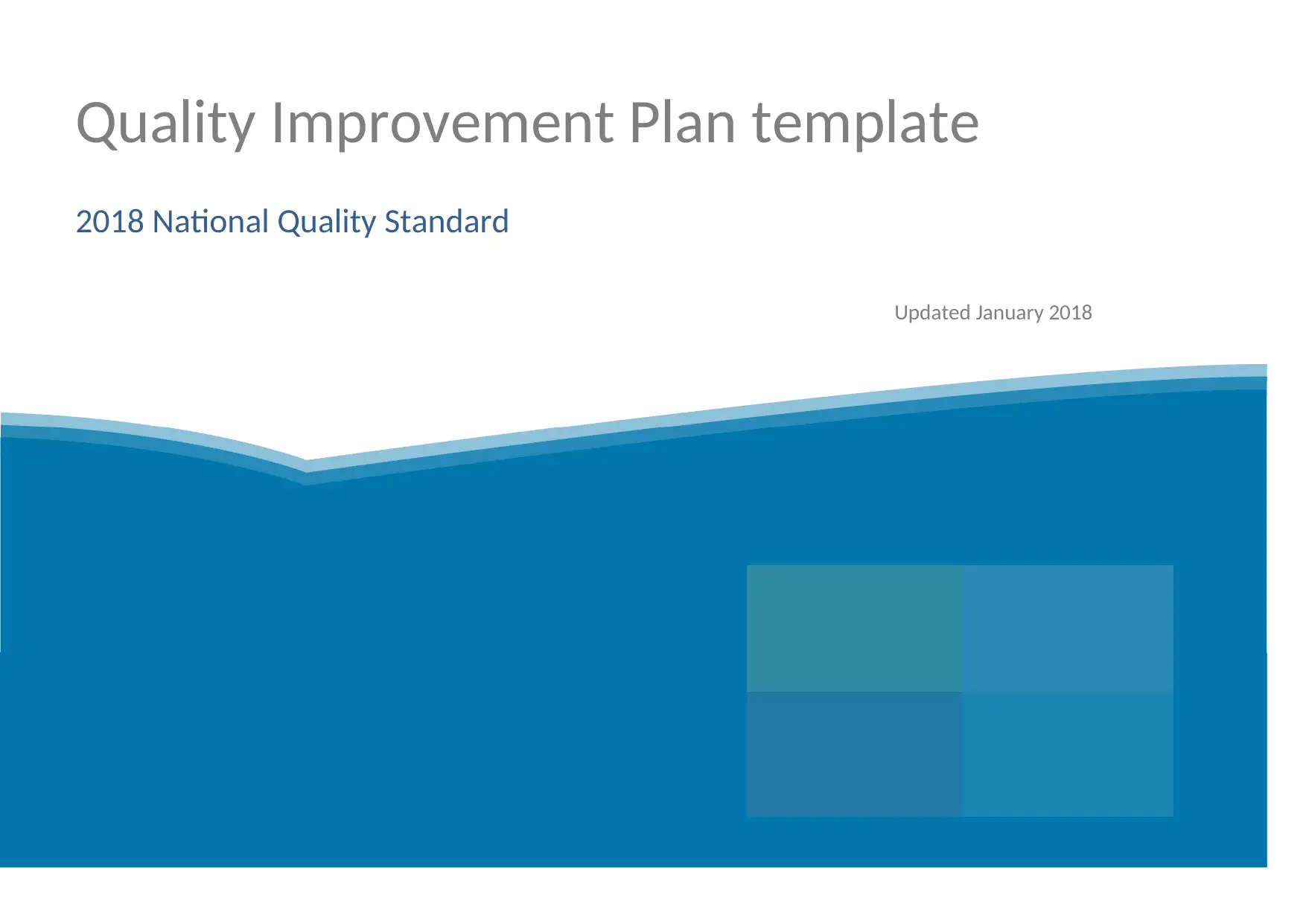
Quality Improvement Plan template
2018 National Quality Standard
Updated January 2018
2018 National Quality Standard
Updated January 2018
Paraphrase This Document
Need a fresh take? Get an instant paraphrase of this document with our AI Paraphraser
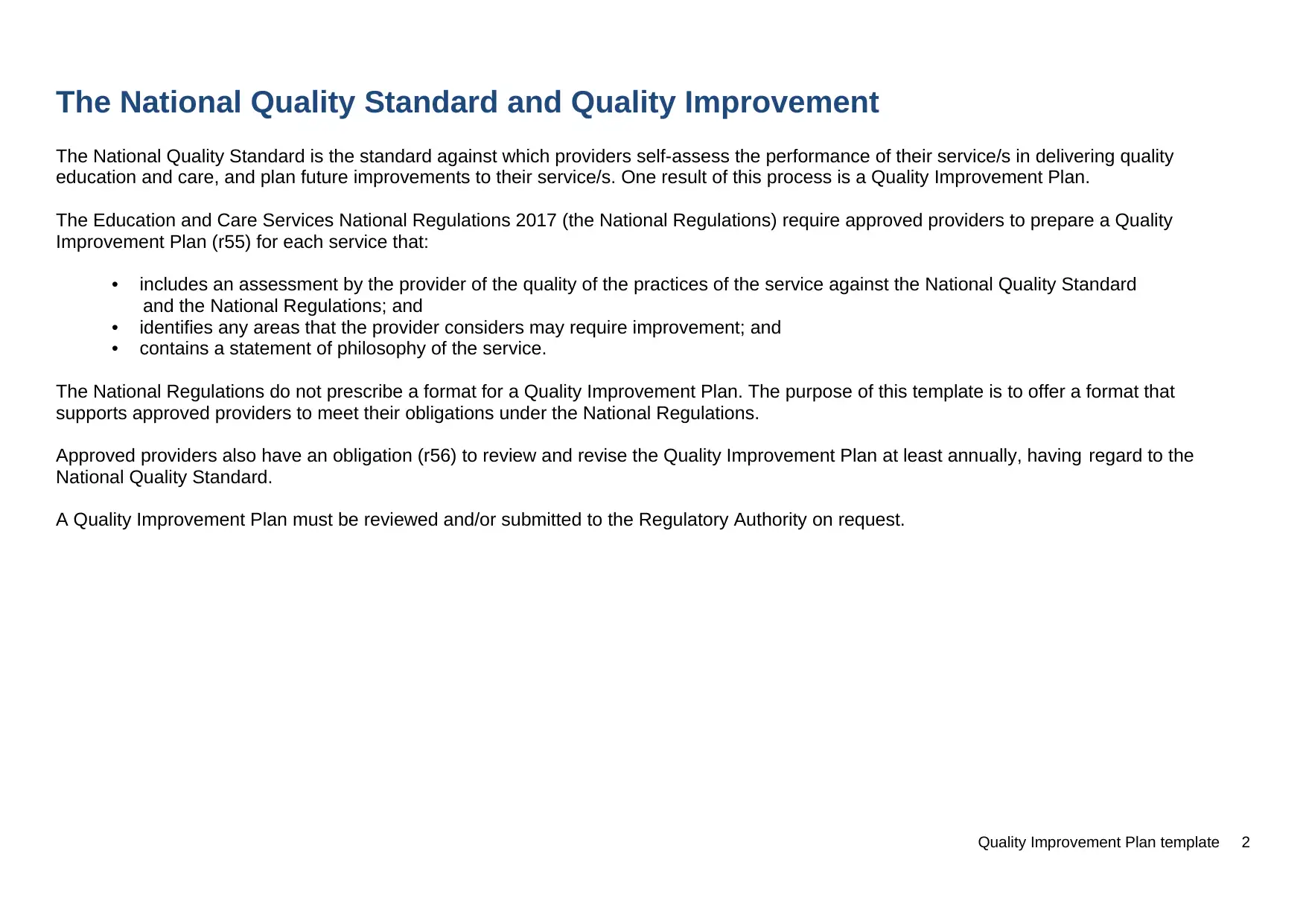
The National Quality Standard and Quality Improvement
The National Quality Standard is the standard against which providers self-assess the performance of their service/s in delivering quality
education and care, and plan future improvements to their service/s. One result of this process is a Quality Improvement Plan.
The Education and Care Services National Regulations 2017 (the National Regulations) require approved providers to prepare a Quality
Improvement Plan (r55) for each service that:
• includes an assessment by the provider of the quality of the practices of the service against the National Quality Standard
and the National Regulations; and
• identifies any areas that the provider considers may require improvement; and
• contains a statement of philosophy of the service.
The National Regulations do not prescribe a format for a Quality Improvement Plan. The purpose of this template is to offer a format that
supports approved providers to meet their obligations under the National Regulations.
Approved providers also have an obligation (r56) to review and revise the Quality Improvement Plan at least annually, having regard to the
National Quality Standard.
A Quality Improvement Plan must be reviewed and/or submitted to the Regulatory Authority on request.
Quality Improvement Plan template 2
The National Quality Standard is the standard against which providers self-assess the performance of their service/s in delivering quality
education and care, and plan future improvements to their service/s. One result of this process is a Quality Improvement Plan.
The Education and Care Services National Regulations 2017 (the National Regulations) require approved providers to prepare a Quality
Improvement Plan (r55) for each service that:
• includes an assessment by the provider of the quality of the practices of the service against the National Quality Standard
and the National Regulations; and
• identifies any areas that the provider considers may require improvement; and
• contains a statement of philosophy of the service.
The National Regulations do not prescribe a format for a Quality Improvement Plan. The purpose of this template is to offer a format that
supports approved providers to meet their obligations under the National Regulations.
Approved providers also have an obligation (r56) to review and revise the Quality Improvement Plan at least annually, having regard to the
National Quality Standard.
A Quality Improvement Plan must be reviewed and/or submitted to the Regulatory Authority on request.
Quality Improvement Plan template 2
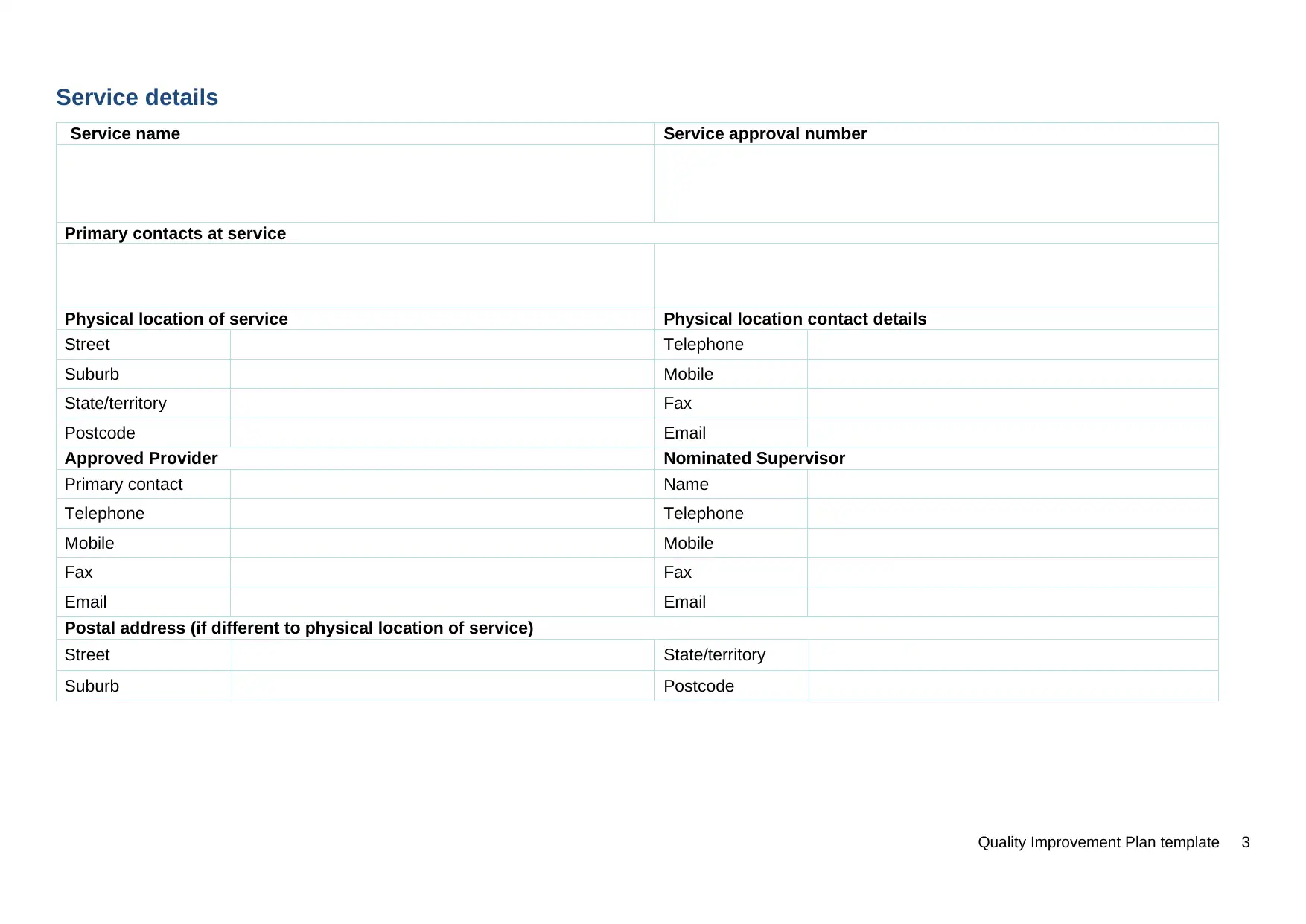
Service details
Service name Service approval number
Primary contacts at service
Physical location of service Physical location contact details
Street Telephone
Suburb Mobile
State/territory Fax
Postcode Email
Approved Provider Nominated Supervisor
Primary contact Name
Telephone Telephone
Mobile Mobile
Fax Fax
Email Email
Postal address (if different to physical location of service)
Street State/territory
Suburb Postcode
Quality Improvement Plan template 3
Service name Service approval number
Primary contacts at service
Physical location of service Physical location contact details
Street Telephone
Suburb Mobile
State/territory Fax
Postcode Email
Approved Provider Nominated Supervisor
Primary contact Name
Telephone Telephone
Mobile Mobile
Fax Fax
Email Email
Postal address (if different to physical location of service)
Street State/territory
Suburb Postcode
Quality Improvement Plan template 3
⊘ This is a preview!⊘
Do you want full access?
Subscribe today to unlock all pages.

Trusted by 1+ million students worldwide
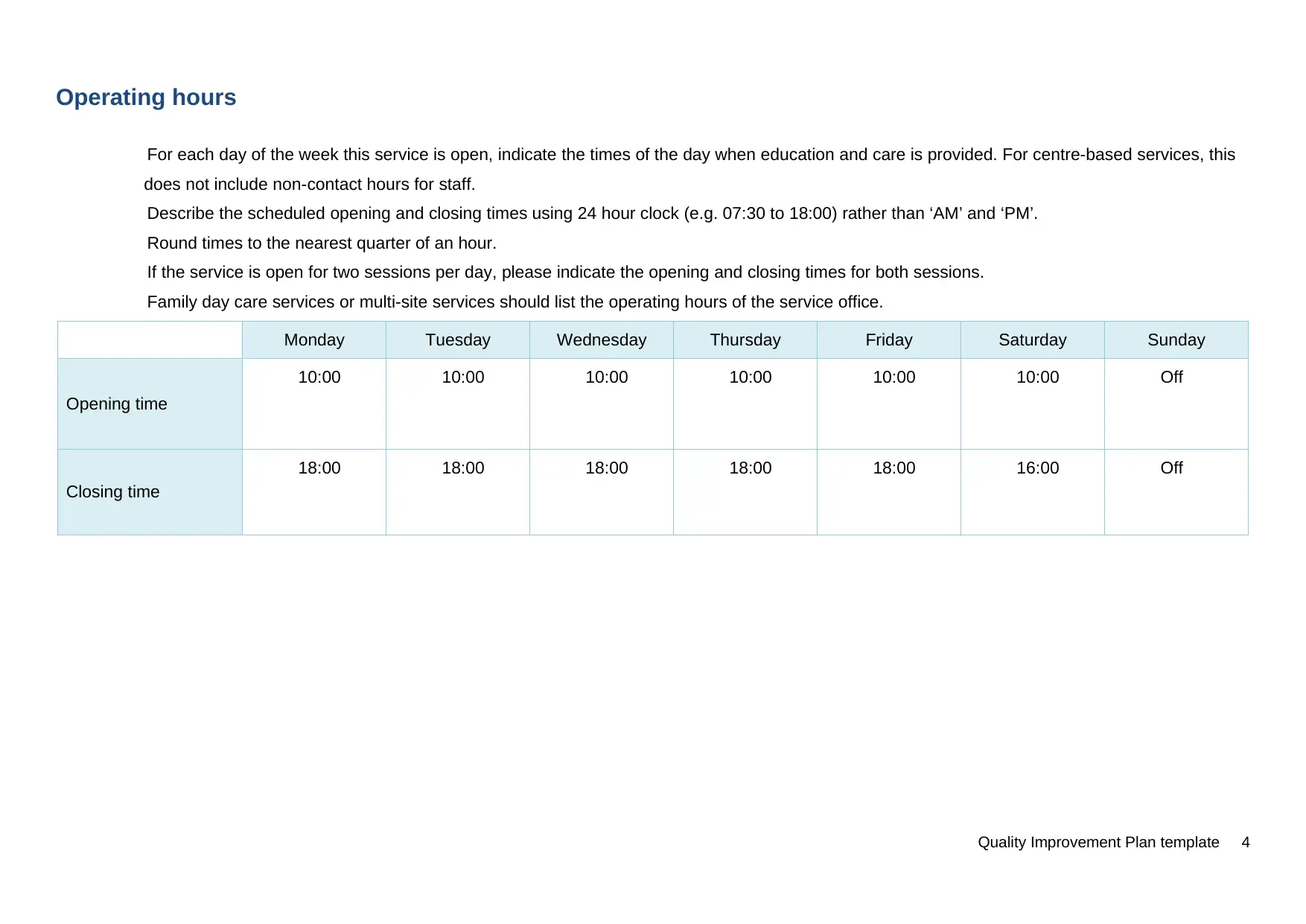
Operating hours
For each day of the week this service is open, indicate the times of the day when education and care is provided. For centre-based services, this
does not include non-contact hours for staff.
Describe the scheduled opening and closing times using 24 hour clock (e.g. 07:30 to 18:00) rather than ‘AM’ and ‘PM’.
Round times to the nearest quarter of an hour.
If the service is open for two sessions per day, please indicate the opening and closing times for both sessions.
Family day care services or multi-site services should list the operating hours of the service office.
Monday Tuesday Wednesday Thursday Friday Saturday Sunday
Opening time
10:00 10:00 10:00 10:00 10:00 10:00 Off
Closing time
18:00 18:00 18:00 18:00 18:00 16:00 Off
Quality Improvement Plan template 4
For each day of the week this service is open, indicate the times of the day when education and care is provided. For centre-based services, this
does not include non-contact hours for staff.
Describe the scheduled opening and closing times using 24 hour clock (e.g. 07:30 to 18:00) rather than ‘AM’ and ‘PM’.
Round times to the nearest quarter of an hour.
If the service is open for two sessions per day, please indicate the opening and closing times for both sessions.
Family day care services or multi-site services should list the operating hours of the service office.
Monday Tuesday Wednesday Thursday Friday Saturday Sunday
Opening time
10:00 10:00 10:00 10:00 10:00 10:00 Off
Closing time
18:00 18:00 18:00 18:00 18:00 16:00 Off
Quality Improvement Plan template 4
Paraphrase This Document
Need a fresh take? Get an instant paraphrase of this document with our AI Paraphraser

Additional information about your service
The following information will assist the Regulatory Authority to plan the assessment visit.
Additional service is parking facility. This organisation maintains the environment (external) and cark parking facility is a major factor.
How are the children grouped at your service?
Children of 5-7 years have been categorised in group A, 8-10 in group B and 11-13 in group C
Write the name and position of person(s) responsible for submitting this Quality Improvement Plan (e.g. Cheryl Smith, Nominated Supervisor)
For family day care services, indicate the number of educators currently registered in the service and attach a list of the educators and their addresses.
No. of educators:_____5____
Quality Improvement Plan template 5
The following information will assist the Regulatory Authority to plan the assessment visit.
Additional service is parking facility. This organisation maintains the environment (external) and cark parking facility is a major factor.
How are the children grouped at your service?
Children of 5-7 years have been categorised in group A, 8-10 in group B and 11-13 in group C
Write the name and position of person(s) responsible for submitting this Quality Improvement Plan (e.g. Cheryl Smith, Nominated Supervisor)
For family day care services, indicate the number of educators currently registered in the service and attach a list of the educators and their addresses.
No. of educators:_____5____
Quality Improvement Plan template 5
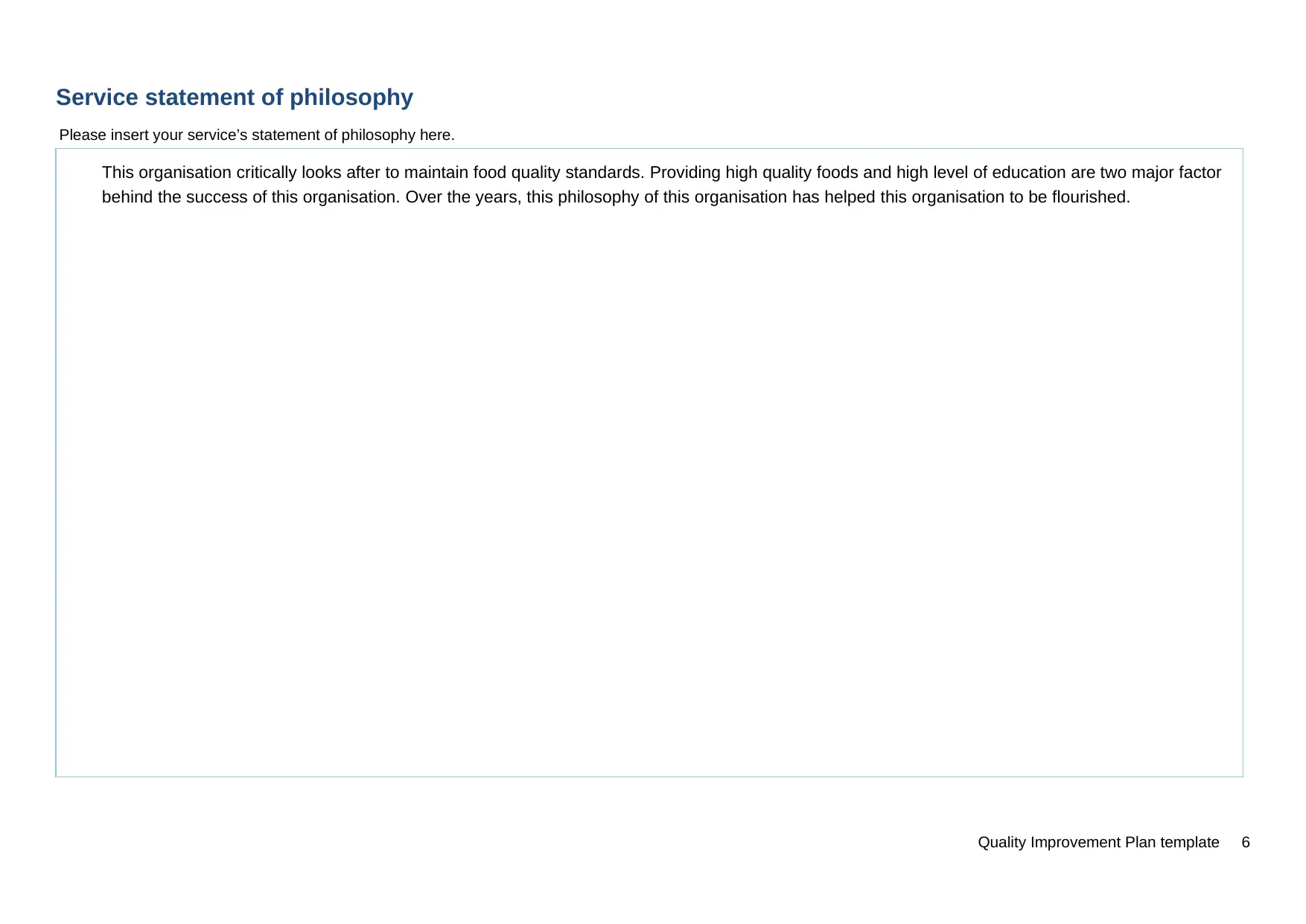
Service statement of philosophy
Please insert your service’s statement of philosophy here.
This organisation critically looks after to maintain food quality standards. Providing high quality foods and high level of education are two major factor
behind the success of this organisation. Over the years, this philosophy of this organisation has helped this organisation to be flourished.
Quality Improvement Plan template 6
Please insert your service’s statement of philosophy here.
This organisation critically looks after to maintain food quality standards. Providing high quality foods and high level of education are two major factor
behind the success of this organisation. Over the years, this philosophy of this organisation has helped this organisation to be flourished.
Quality Improvement Plan template 6
⊘ This is a preview!⊘
Do you want full access?
Subscribe today to unlock all pages.

Trusted by 1+ million students worldwide
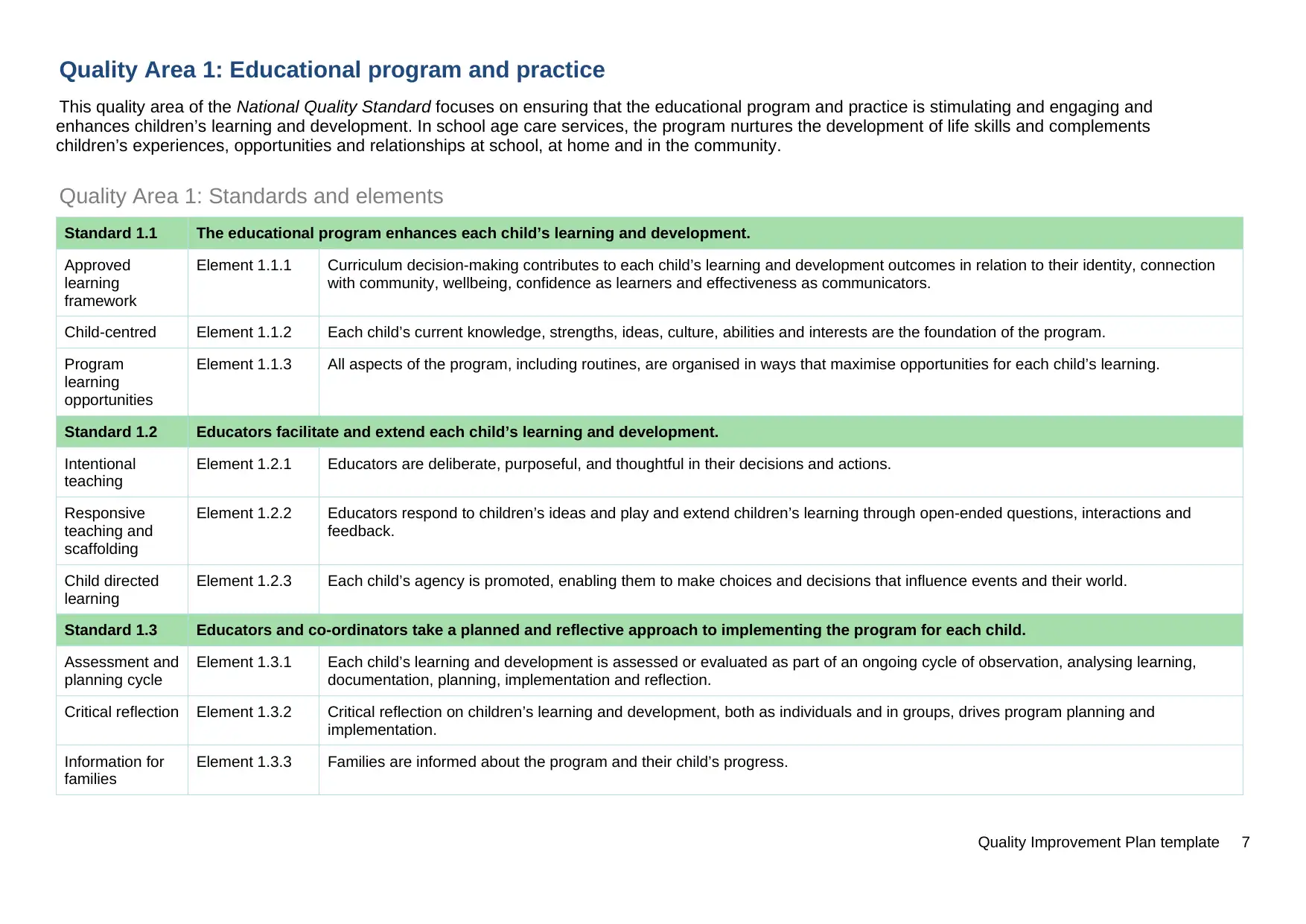
Quality Area 1: Educational program and practice
This quality area of the National Quality Standard focuses on ensuring that the educational program and practice is stimulating and engaging and
enhances children’s learning and development. In school age care services, the program nurtures the development of life skills and complements
children’s experiences, opportunities and relationships at school, at home and in the community.
Quality Area 1: Standards and elements
Standard 1.1 The educational program enhances each child’s learning and development.
Approved
learning
framework
Element 1.1.1 Curriculum decision-making contributes to each child’s learning and development outcomes in relation to their identity, connection
with community, wellbeing, confidence as learners and effectiveness as communicators.
Child-centred Element 1.1.2 Each child’s current knowledge, strengths, ideas, culture, abilities and interests are the foundation of the program.
Program
learning
opportunities
Element 1.1.3 All aspects of the program, including routines, are organised in ways that maximise opportunities for each child’s learning.
Standard 1.2 Educators facilitate and extend each child’s learning and development.
Intentional
teaching
Element 1.2.1 Educators are deliberate, purposeful, and thoughtful in their decisions and actions.
Responsive
teaching and
scaffolding
Element 1.2.2 Educators respond to children’s ideas and play and extend children’s learning through open-ended questions, interactions and
feedback.
Child directed
learning
Element 1.2.3 Each child’s agency is promoted, enabling them to make choices and decisions that influence events and their world.
Standard 1.3 Educators and co-ordinators take a planned and reflective approach to implementing the program for each child.
Assessment and
planning cycle
Element 1.3.1 Each child’s learning and development is assessed or evaluated as part of an ongoing cycle of observation, analysing learning,
documentation, planning, implementation and reflection.
Critical reflection Element 1.3.2 Critical reflection on children’s learning and development, both as individuals and in groups, drives program planning and
implementation.
Information for
families
Element 1.3.3 Families are informed about the program and their child’s progress.
Quality Improvement Plan template 7
This quality area of the National Quality Standard focuses on ensuring that the educational program and practice is stimulating and engaging and
enhances children’s learning and development. In school age care services, the program nurtures the development of life skills and complements
children’s experiences, opportunities and relationships at school, at home and in the community.
Quality Area 1: Standards and elements
Standard 1.1 The educational program enhances each child’s learning and development.
Approved
learning
framework
Element 1.1.1 Curriculum decision-making contributes to each child’s learning and development outcomes in relation to their identity, connection
with community, wellbeing, confidence as learners and effectiveness as communicators.
Child-centred Element 1.1.2 Each child’s current knowledge, strengths, ideas, culture, abilities and interests are the foundation of the program.
Program
learning
opportunities
Element 1.1.3 All aspects of the program, including routines, are organised in ways that maximise opportunities for each child’s learning.
Standard 1.2 Educators facilitate and extend each child’s learning and development.
Intentional
teaching
Element 1.2.1 Educators are deliberate, purposeful, and thoughtful in their decisions and actions.
Responsive
teaching and
scaffolding
Element 1.2.2 Educators respond to children’s ideas and play and extend children’s learning through open-ended questions, interactions and
feedback.
Child directed
learning
Element 1.2.3 Each child’s agency is promoted, enabling them to make choices and decisions that influence events and their world.
Standard 1.3 Educators and co-ordinators take a planned and reflective approach to implementing the program for each child.
Assessment and
planning cycle
Element 1.3.1 Each child’s learning and development is assessed or evaluated as part of an ongoing cycle of observation, analysing learning,
documentation, planning, implementation and reflection.
Critical reflection Element 1.3.2 Critical reflection on children’s learning and development, both as individuals and in groups, drives program planning and
implementation.
Information for
families
Element 1.3.3 Families are informed about the program and their child’s progress.
Quality Improvement Plan template 7
Paraphrase This Document
Need a fresh take? Get an instant paraphrase of this document with our AI Paraphraser
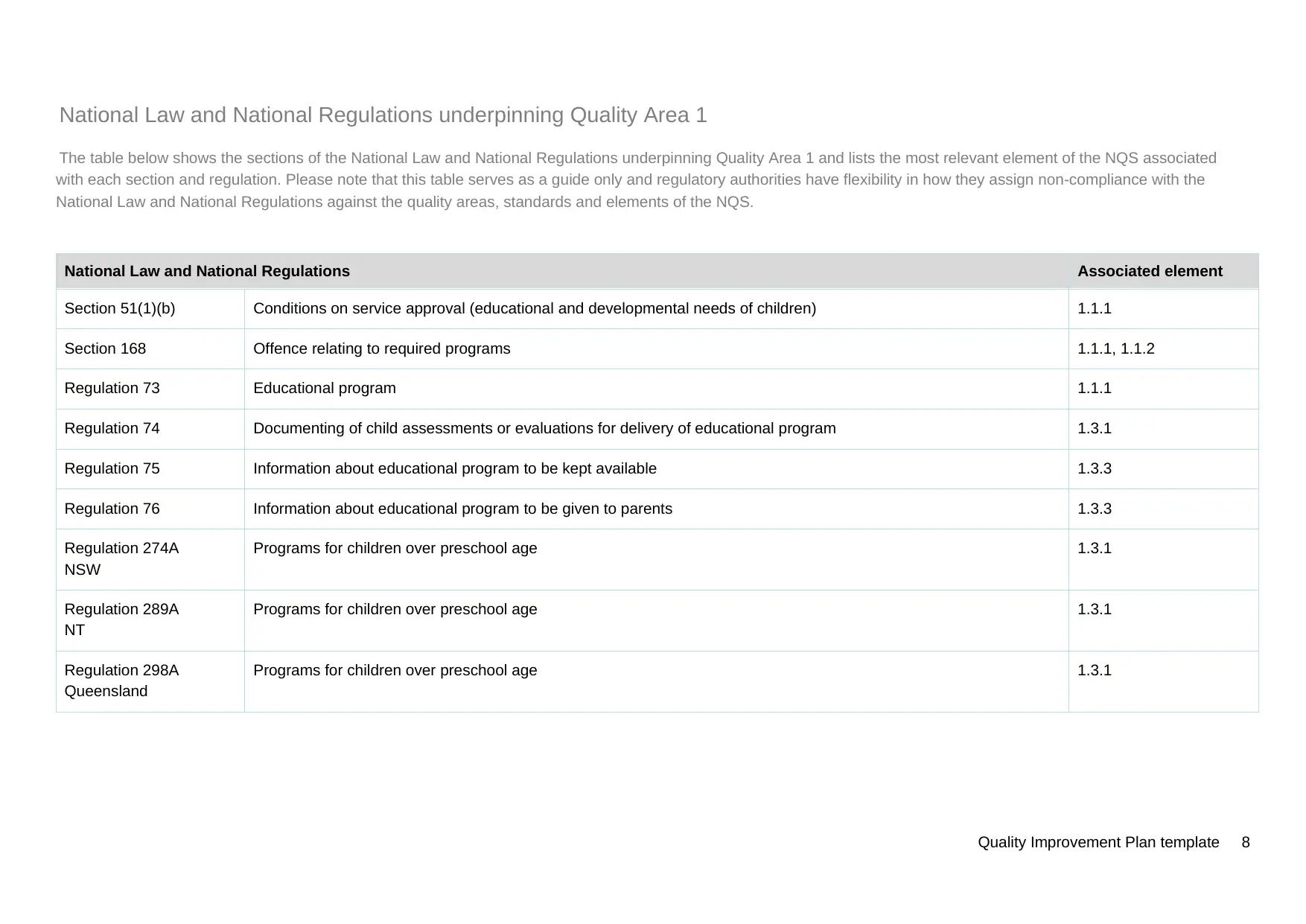
National Law and National Regulations underpinning Quality Area 1
The table below shows the sections of the National Law and National Regulations underpinning Quality Area 1 and lists the most relevant element of the NQS associated
with each section and regulation. Please note that this table serves as a guide only and regulatory authorities have flexibility in how they assign non-compliance with the
National Law and National Regulations against the quality areas, standards and elements of the NQS.
National Law and National Regulations Associated element
Section 51(1)(b) Conditions on service approval (educational and developmental needs of children) 1.1.1
Section 168 Offence relating to required programs 1.1.1, 1.1.2
Regulation 73 Educational program 1.1.1
Regulation 74 Documenting of child assessments or evaluations for delivery of educational program 1.3.1
Regulation 75 Information about educational program to be kept available 1.3.3
Regulation 76 Information about educational program to be given to parents 1.3.3
Regulation 274A
NSW
Programs for children over preschool age 1.3.1
Regulation 289A
NT
Programs for children over preschool age 1.3.1
Regulation 298A
Queensland
Programs for children over preschool age 1.3.1
Quality Improvement Plan template 8
The table below shows the sections of the National Law and National Regulations underpinning Quality Area 1 and lists the most relevant element of the NQS associated
with each section and regulation. Please note that this table serves as a guide only and regulatory authorities have flexibility in how they assign non-compliance with the
National Law and National Regulations against the quality areas, standards and elements of the NQS.
National Law and National Regulations Associated element
Section 51(1)(b) Conditions on service approval (educational and developmental needs of children) 1.1.1
Section 168 Offence relating to required programs 1.1.1, 1.1.2
Regulation 73 Educational program 1.1.1
Regulation 74 Documenting of child assessments or evaluations for delivery of educational program 1.3.1
Regulation 75 Information about educational program to be kept available 1.3.3
Regulation 76 Information about educational program to be given to parents 1.3.3
Regulation 274A
NSW
Programs for children over preschool age 1.3.1
Regulation 289A
NT
Programs for children over preschool age 1.3.1
Regulation 298A
Queensland
Programs for children over preschool age 1.3.1
Quality Improvement Plan template 8
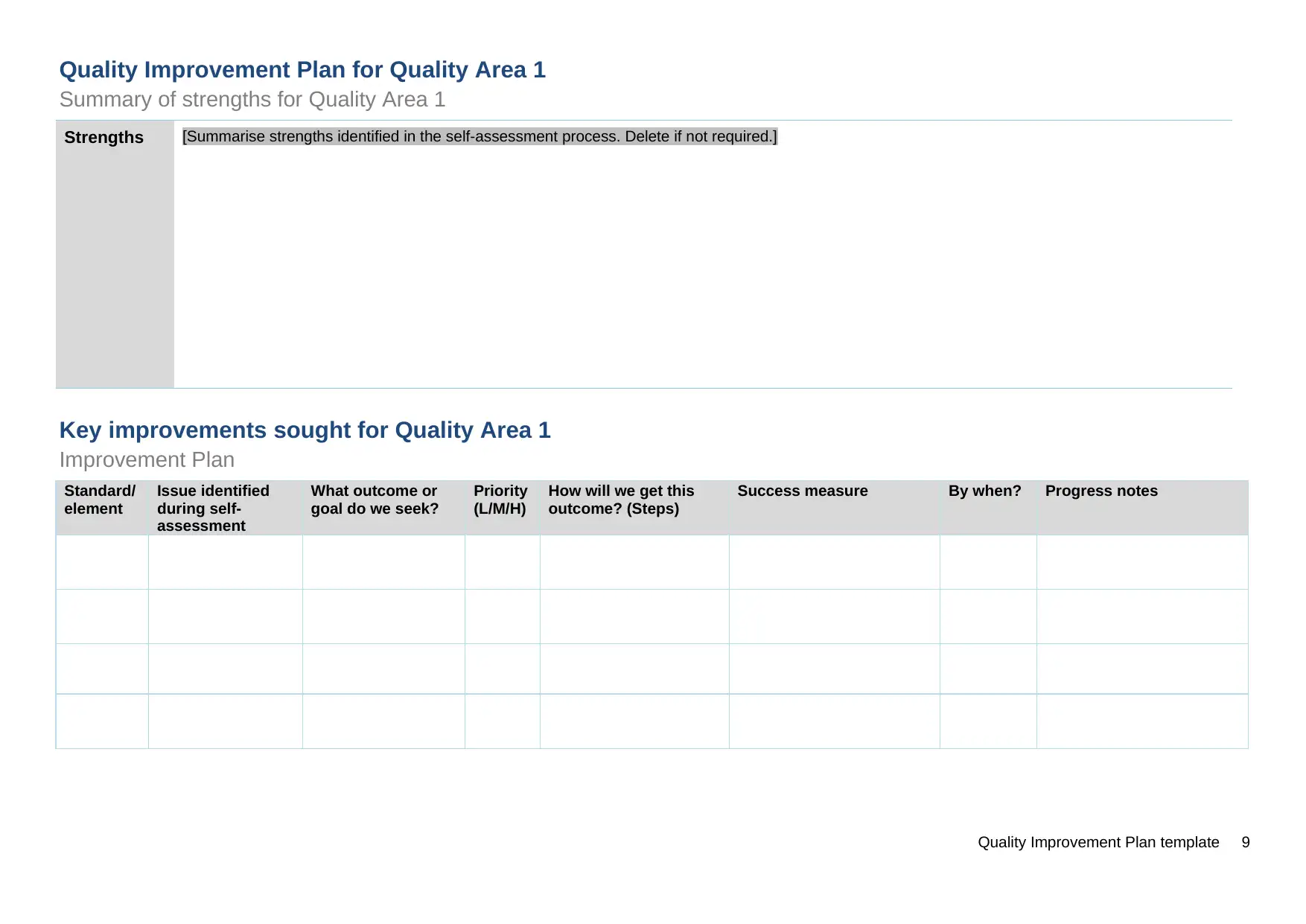
Quality Improvement Plan for Quality Area 1
Summary of strengths for Quality Area 1
Strengths [Summarise strengths identified in the self-assessment process. Delete if not required.]
Key improvements sought for Quality Area 1
Improvement Plan
Standard/
element
Issue identified
during self-
assessment
What outcome or
goal do we seek?
Priority
(L/M/H)
How will we get this
outcome? (Steps)
Success measure By when? Progress notes
Quality Improvement Plan template 9
Summary of strengths for Quality Area 1
Strengths [Summarise strengths identified in the self-assessment process. Delete if not required.]
Key improvements sought for Quality Area 1
Improvement Plan
Standard/
element
Issue identified
during self-
assessment
What outcome or
goal do we seek?
Priority
(L/M/H)
How will we get this
outcome? (Steps)
Success measure By when? Progress notes
Quality Improvement Plan template 9
⊘ This is a preview!⊘
Do you want full access?
Subscribe today to unlock all pages.

Trusted by 1+ million students worldwide
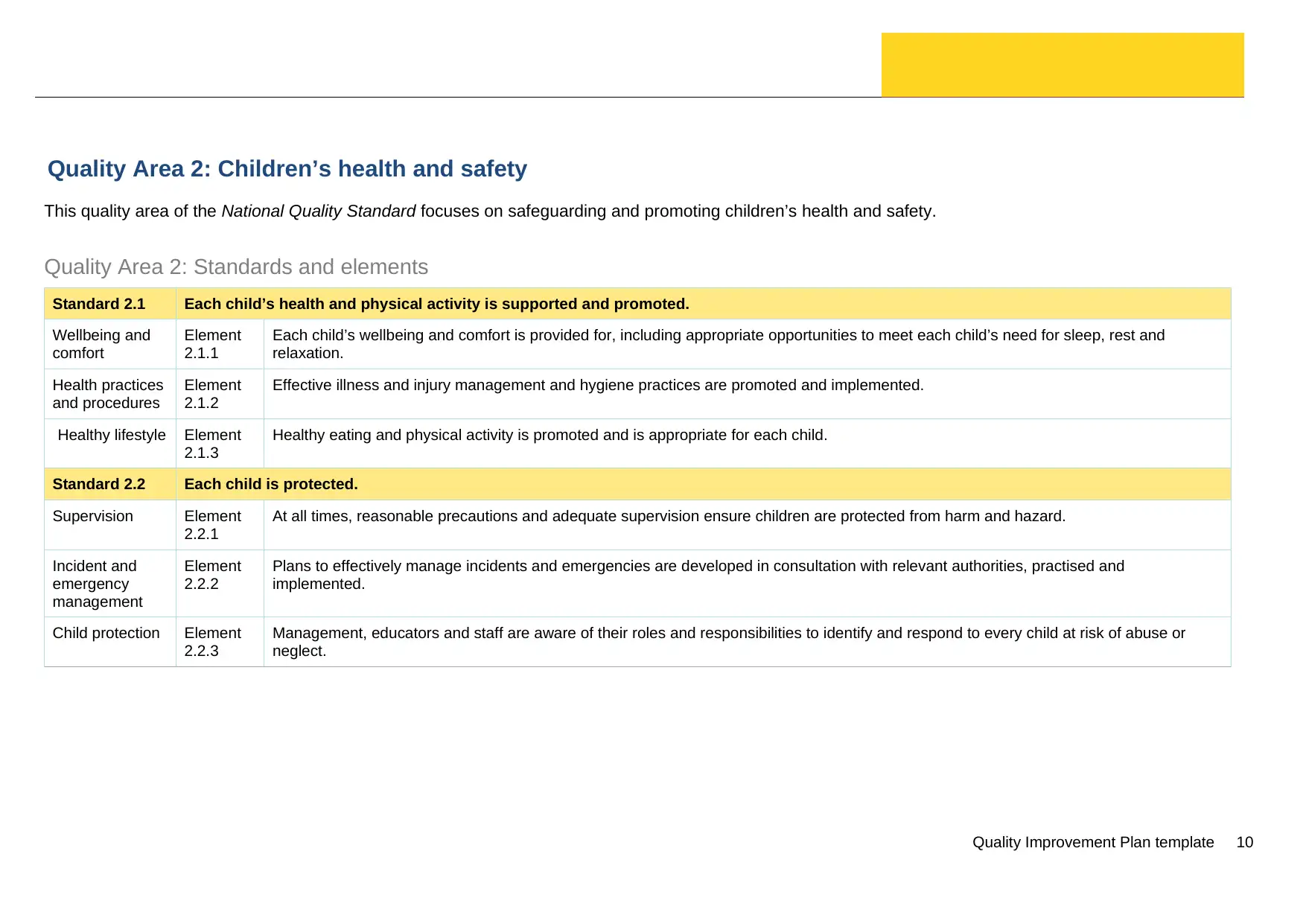
Quality Area 2: Children’s health and safety
This quality area of the National Quality Standard focuses on safeguarding and promoting children’s health and safety.
Quality Area 2: Standards and elements
Standard 2.1 Each child’s health and physical activity is supported and promoted.
Wellbeing and
comfort
Element
2.1.1
Each child’s wellbeing and comfort is provided for, including appropriate opportunities to meet each child’s need for sleep, rest and
relaxation.
Health practices
and procedures
Element
2.1.2
Effective illness and injury management and hygiene practices are promoted and implemented.
Healthy lifestyle Element
2.1.3
Healthy eating and physical activity is promoted and is appropriate for each child.
Standard 2.2 Each child is protected.
Supervision Element
2.2.1
At all times, reasonable precautions and adequate supervision ensure children are protected from harm and hazard.
Incident and
emergency
management
Element
2.2.2
Plans to effectively manage incidents and emergencies are developed in consultation with relevant authorities, practised and
implemented.
Child protection Element
2.2.3
Management, educators and staff are aware of their roles and responsibilities to identify and respond to every child at risk of abuse or
neglect.
Quality Improvement Plan template 10
This quality area of the National Quality Standard focuses on safeguarding and promoting children’s health and safety.
Quality Area 2: Standards and elements
Standard 2.1 Each child’s health and physical activity is supported and promoted.
Wellbeing and
comfort
Element
2.1.1
Each child’s wellbeing and comfort is provided for, including appropriate opportunities to meet each child’s need for sleep, rest and
relaxation.
Health practices
and procedures
Element
2.1.2
Effective illness and injury management and hygiene practices are promoted and implemented.
Healthy lifestyle Element
2.1.3
Healthy eating and physical activity is promoted and is appropriate for each child.
Standard 2.2 Each child is protected.
Supervision Element
2.2.1
At all times, reasonable precautions and adequate supervision ensure children are protected from harm and hazard.
Incident and
emergency
management
Element
2.2.2
Plans to effectively manage incidents and emergencies are developed in consultation with relevant authorities, practised and
implemented.
Child protection Element
2.2.3
Management, educators and staff are aware of their roles and responsibilities to identify and respond to every child at risk of abuse or
neglect.
Quality Improvement Plan template 10
Paraphrase This Document
Need a fresh take? Get an instant paraphrase of this document with our AI Paraphraser
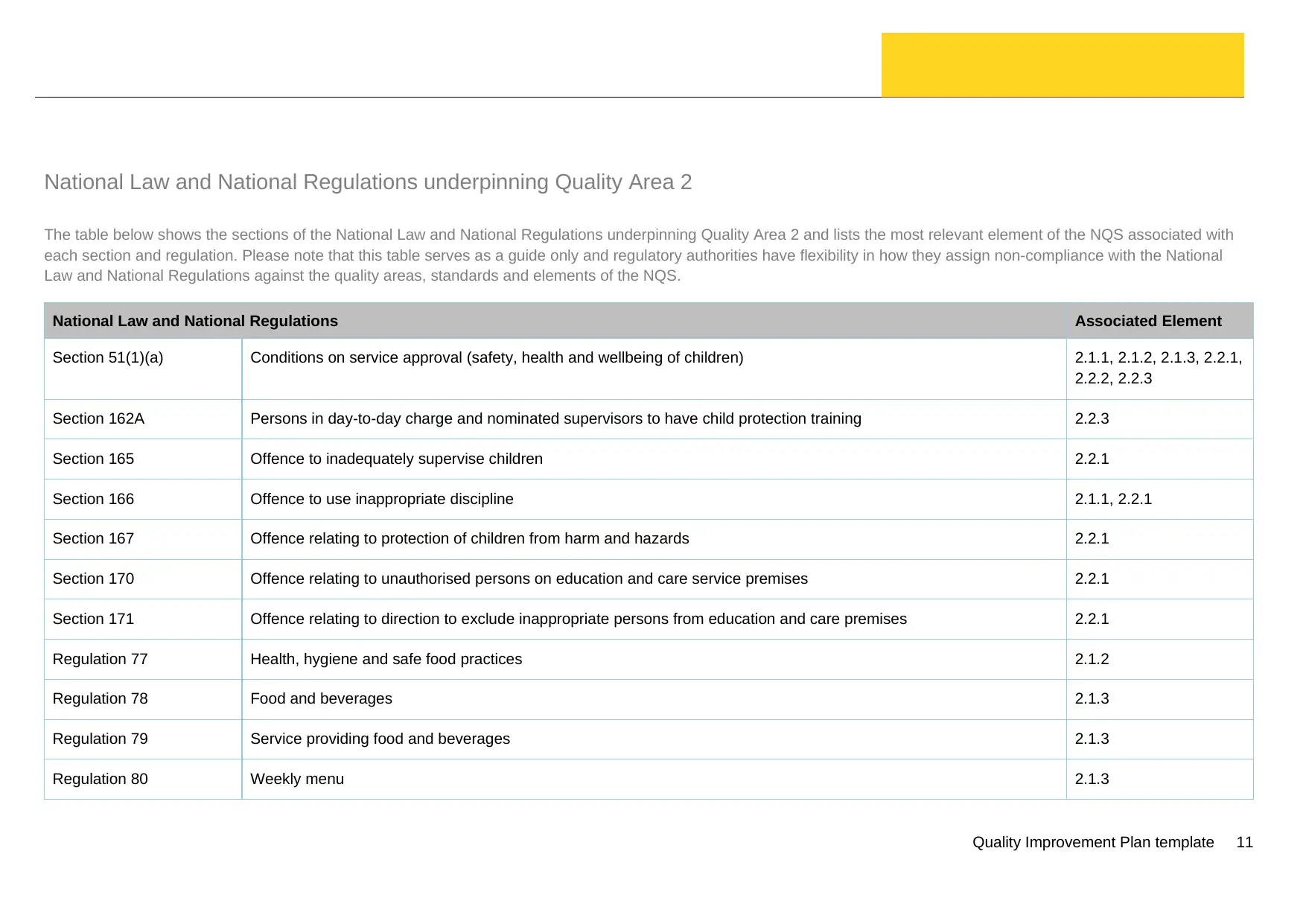
National Law and National Regulations underpinning Quality Area 2
The table below shows the sections of the National Law and National Regulations underpinning Quality Area 2 and lists the most relevant element of the NQS associated with
each section and regulation. Please note that this table serves as a guide only and regulatory authorities have flexibility in how they assign non-compliance with the National
Law and National Regulations against the quality areas, standards and elements of the NQS.
National Law and National Regulations Associated Element
Section 51(1)(a) Conditions on service approval (safety, health and wellbeing of children) 2.1.1, 2.1.2, 2.1.3, 2.2.1,
2.2.2, 2.2.3
Section 162A Persons in day-to-day charge and nominated supervisors to have child protection training 2.2.3
Section 165 Offence to inadequately supervise children 2.2.1
Section 166 Offence to use inappropriate discipline 2.1.1, 2.2.1
Section 167 Offence relating to protection of children from harm and hazards 2.2.1
Section 170 Offence relating to unauthorised persons on education and care service premises 2.2.1
Section 171 Offence relating to direction to exclude inappropriate persons from education and care premises 2.2.1
Regulation 77 Health, hygiene and safe food practices 2.1.2
Regulation 78 Food and beverages 2.1.3
Regulation 79 Service providing food and beverages 2.1.3
Regulation 80 Weekly menu 2.1.3
Quality Improvement Plan template 11
The table below shows the sections of the National Law and National Regulations underpinning Quality Area 2 and lists the most relevant element of the NQS associated with
each section and regulation. Please note that this table serves as a guide only and regulatory authorities have flexibility in how they assign non-compliance with the National
Law and National Regulations against the quality areas, standards and elements of the NQS.
National Law and National Regulations Associated Element
Section 51(1)(a) Conditions on service approval (safety, health and wellbeing of children) 2.1.1, 2.1.2, 2.1.3, 2.2.1,
2.2.2, 2.2.3
Section 162A Persons in day-to-day charge and nominated supervisors to have child protection training 2.2.3
Section 165 Offence to inadequately supervise children 2.2.1
Section 166 Offence to use inappropriate discipline 2.1.1, 2.2.1
Section 167 Offence relating to protection of children from harm and hazards 2.2.1
Section 170 Offence relating to unauthorised persons on education and care service premises 2.2.1
Section 171 Offence relating to direction to exclude inappropriate persons from education and care premises 2.2.1
Regulation 77 Health, hygiene and safe food practices 2.1.2
Regulation 78 Food and beverages 2.1.3
Regulation 79 Service providing food and beverages 2.1.3
Regulation 80 Weekly menu 2.1.3
Quality Improvement Plan template 11
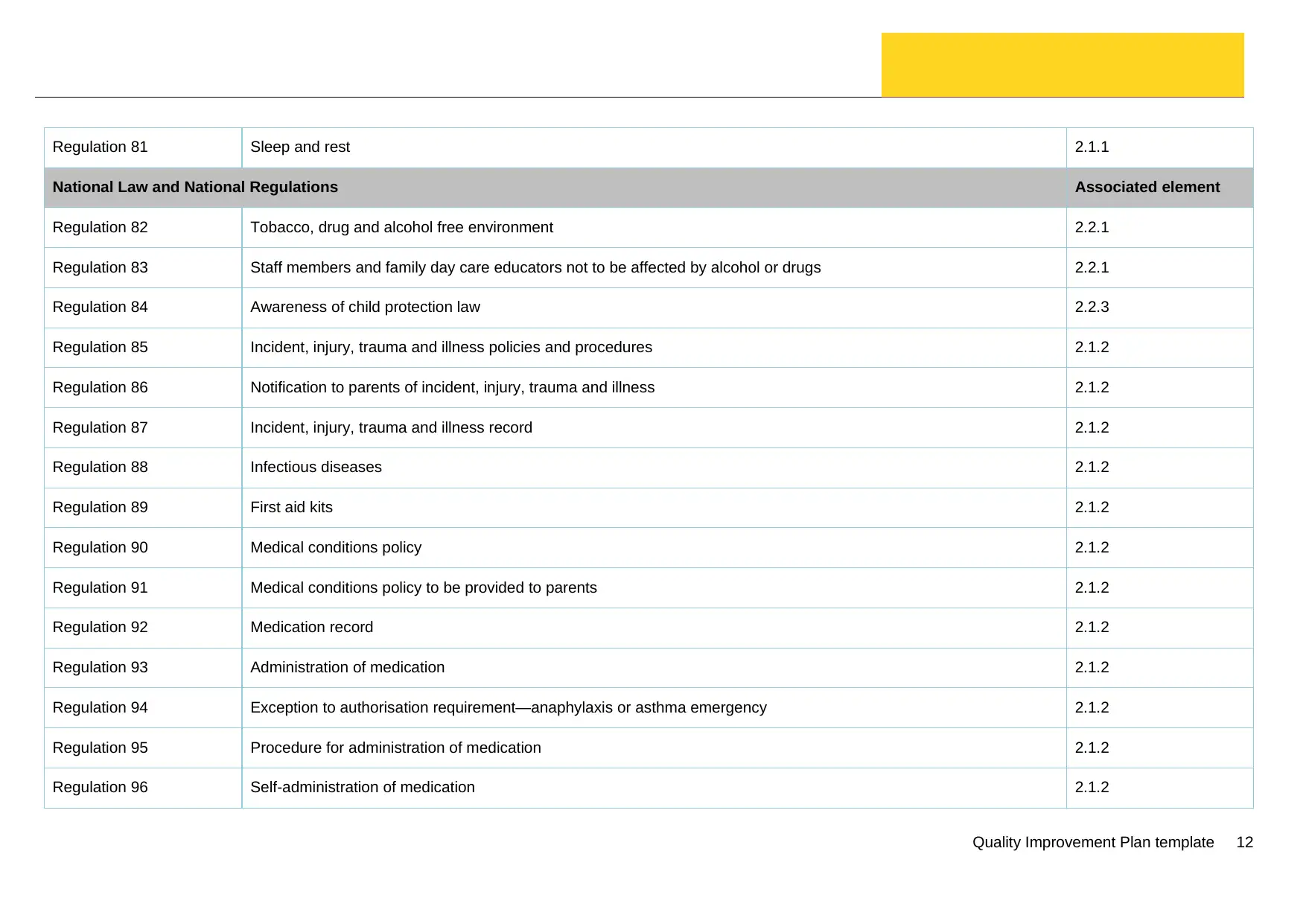
Regulation 81 Sleep and rest 2.1.1
National Law and National Regulations Associated element
Regulation 82 Tobacco, drug and alcohol free environment 2.2.1
Regulation 83 Staff members and family day care educators not to be affected by alcohol or drugs 2.2.1
Regulation 84 Awareness of child protection law 2.2.3
Regulation 85 Incident, injury, trauma and illness policies and procedures 2.1.2
Regulation 86 Notification to parents of incident, injury, trauma and illness 2.1.2
Regulation 87 Incident, injury, trauma and illness record 2.1.2
Regulation 88 Infectious diseases 2.1.2
Regulation 89 First aid kits 2.1.2
Regulation 90 Medical conditions policy 2.1.2
Regulation 91 Medical conditions policy to be provided to parents 2.1.2
Regulation 92 Medication record 2.1.2
Regulation 93 Administration of medication 2.1.2
Regulation 94 Exception to authorisation requirement—anaphylaxis or asthma emergency 2.1.2
Regulation 95 Procedure for administration of medication 2.1.2
Regulation 96 Self-administration of medication 2.1.2
Quality Improvement Plan template 12
National Law and National Regulations Associated element
Regulation 82 Tobacco, drug and alcohol free environment 2.2.1
Regulation 83 Staff members and family day care educators not to be affected by alcohol or drugs 2.2.1
Regulation 84 Awareness of child protection law 2.2.3
Regulation 85 Incident, injury, trauma and illness policies and procedures 2.1.2
Regulation 86 Notification to parents of incident, injury, trauma and illness 2.1.2
Regulation 87 Incident, injury, trauma and illness record 2.1.2
Regulation 88 Infectious diseases 2.1.2
Regulation 89 First aid kits 2.1.2
Regulation 90 Medical conditions policy 2.1.2
Regulation 91 Medical conditions policy to be provided to parents 2.1.2
Regulation 92 Medication record 2.1.2
Regulation 93 Administration of medication 2.1.2
Regulation 94 Exception to authorisation requirement—anaphylaxis or asthma emergency 2.1.2
Regulation 95 Procedure for administration of medication 2.1.2
Regulation 96 Self-administration of medication 2.1.2
Quality Improvement Plan template 12
⊘ This is a preview!⊘
Do you want full access?
Subscribe today to unlock all pages.

Trusted by 1+ million students worldwide
1 out of 39
Related Documents
Your All-in-One AI-Powered Toolkit for Academic Success.
+13062052269
info@desklib.com
Available 24*7 on WhatsApp / Email
![[object Object]](/_next/static/media/star-bottom.7253800d.svg)
Unlock your academic potential
Copyright © 2020–2025 A2Z Services. All Rights Reserved. Developed and managed by ZUCOL.




